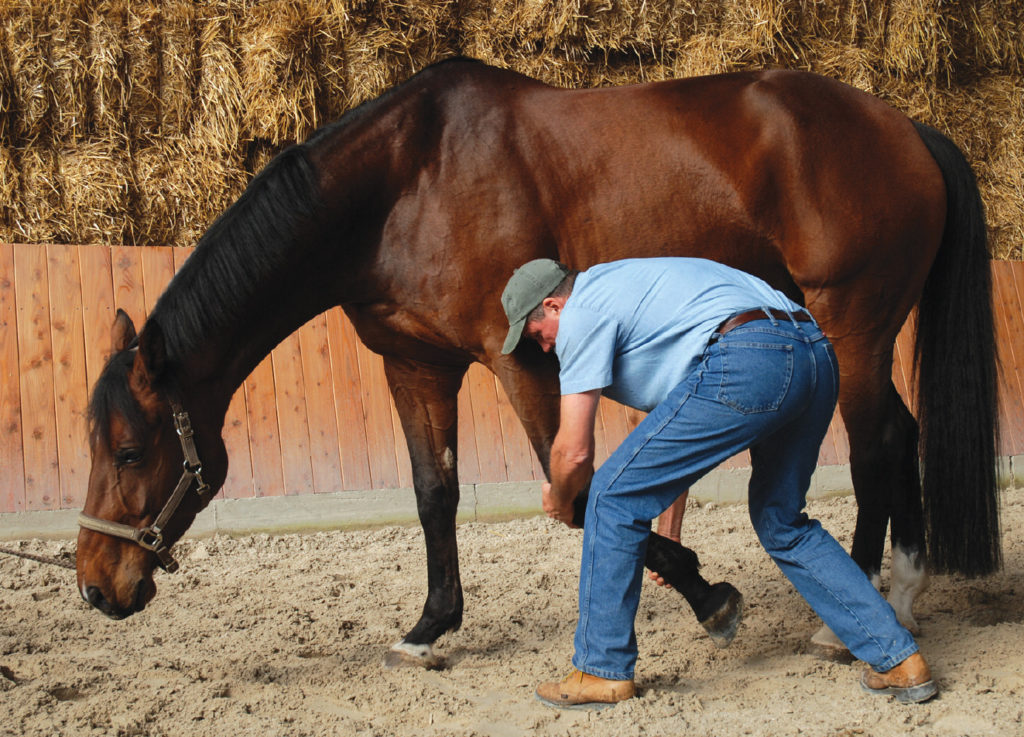An excerpt from Beyond Horse Massage by Jim Masterson with Stefanie Reinhold, reprinted with permission from Trafalgar Square Books (www.horseandriderbooks.com).
Nowadays most hunter-jumpers are larger Warmbloods. They carry most of their weight on the front end. They land on the front end, so feet and legs are constant issues. Consequently, they accumulate a lot of tension in the poll and atlas, and in the lower neck and shoulder. In addition, most hunter-jumpers spend a lot of time in the stall—part of the job, but not necessarily the healthiest thing for the feet or for the horse’s blood circulation. Weight has a big effect on the feet and due to the nature of this sport, hunters carry even more weight on the forehand. Sore feet equate with a sore neck and poll.
In the hind end, hocks and stifles are regular issues in hunter-jumpers. Generally, I find the tension in the hind end easier to release than in other sports such as dressage, but you will come across plenty of horses with hind-end issues. It’s important to keep the lumbar area loose.
For top performance, you will need to keep the mid-back loose, although you may not find as many back problems as you would think compared to some of the other riding disciplines. This may be because the rider spends a lot of time out of the seat, and the horse can carry himself in a more natural frame.
The Masterson Method™ is a form of bodywork that relaxes the horse and relieves his body—including muscles and connective tissue—of deep stress and pain. Through gentle and light manipulation of targeted Release Points; the movement of joints or junctions through a range of motion in a relaxed state; and studied observation of the horse’s responses, you can help your horse release tension and restrictions in his body, while enhancing the communication between you. When using different forms of bodywork—such as the Masterson Method—on a horse before a jumping competition, keep in mind you just want to loosen him up in general. We all have a tendency to want to “get ‘er done” when we come across a problem, and “fix” it; however, just before the horse competes is not the time to do this.
Often, when a muscle has been extremely tight or restricted over a long period of time, it can be sensitive or sore when the tension lets go. This is best avoided right before competing. If you come across excessive resistance, pain, or restriction before an event, pass over it lightly. You can come back to it later.
Individual horses will also respond differently to bodywork in general. Most will be more flexible and have more energy, but with some horses the looseness might come with a little laziness, and the horse might need to be pushed ahead more than usual. When you work on a horse before a competition, it is good to be familiar with him, his issues, and his response to the bodywork.
One standard area for pre-competition bodywork for hunter-jumpers is the scapula. Here is how you do Scapula Releases, using the Masterson Method (and remember that the horse’s responses play an important role in the work):
- Stand at the horse’s shoulder, facing forward.
- Pick up the front foot.
- Rest the horse’s ankle in your right hand and place your left hand on the horse’s knee.
- Allow the horse to relax the leg and shoulder as much as he is able.
- Slowly guide the leg down and back, straightening the leg and lowering the foot as you go. Don’t forget to lower the foot!
- Encourage the horse to rest in this position as long as he can by keeping your hand on the leg or foot.
TIPS
- Perform the Scapula Release gently, keeping in mind that you’re only looking for an improvement, not to “fix” anything.
- If you run into excessive soreness or a restriction, pass over it lightly.
- Don’t spend more than an hour working on a horse just before event time.
- Spend less time asking for movements, and more waiting for the horse to relax into the positions.
- Don’t rush. The horse can tell when you’re hurrying.
Pick up your copy of Beyond Horse Massage from Trafalgar Square Books today!


